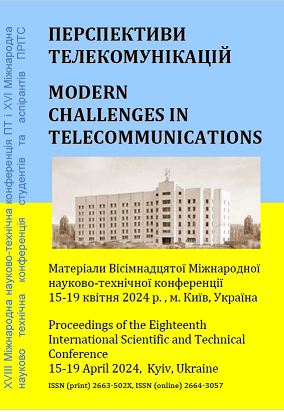ОЦІНКА ШВИДКОСНИХ ХАРАКТЕРИСТИК ТЕХНОЛОГІЇ VDSL2-VECTORING В УМОВАХ ПЕРЕХІДНИХ ЗАВАД
Ключові слова:
VDSL2, ПЕРЕХІДНІ ЗАВАДИ, ВЕКТОРИНГАнотація
Технологія VDSL2-vectoring є вдосконаленням поширеної технології VDSL2, яка використовується у якості «останнього дюйму» в оптоволоконних широкосмугових мережах доступу в архітектурі FTTC (Fiber To The Curb/Cab) та FTTB (Fiber To The Building) для надання різноманітних мультимедійних послуг, включаючи IPTV, OTT та інших. Технологія VDSL2-vectoring дозволяє компенсувати вплив перехідних завад на дальньому кінці кабелю (FEXT) і, таким чином, значно збільшити швидкість передачі на ділянці від точки доступу до приміщень користувачів. Так як FEXT залежить від довжини кабелю, то цікавим є визначення діапазону відстаней, на яких доцільно використовувати технологію VDSL2-vectoring.Посилання
Berrou C., Glavieux A., P. Thitimajshima Near Shannon limit error-correcting coding and decoding: turbo-codes // in Proc. Int. Conf. On Commun., ICC-93. – 1993. – Geneva. – Switzerland. – May. – P. 1064-1070.
Consultative Committee for Space Data Systems, Telemetry Channel Coding. Blue Book, vol. 101.0-B-4, issue 4, May 1999. http://www.ccsds.org/documents/pdf/ CCSDS-101.0-B-4.pdf.
A. Matache, S. Dolinar, F. PollaraStopping Rules for Turbo Decoders // TMO Progress Report 42-142. - Jet Propulsion Laboratory, California Institute of Technology. - August 15, 2000.
Р. Морелос-Сарагоса. Мистецтво завадостійкого кодування. Методи, алгоритми, застосування. Переклад з англійської В.Б. Афанасьєва ТЕХНОСФЕРА.- М.-2005 - 320 с.
С.В.Зайцев, С.П.Лівенцев, Б.В.Горлинський, А.І.Артюх. Імітаційне моделювання характеристик завадостійкості системи передачі інформації з турбокодами // Зв'язок. - 2006. - №7. - С. 38-42.
##submission.downloads##
Опубліковано
Як цитувати
Номер
Розділ
Ліцензія

Ця робота ліцензується відповідно до Creative Commons Attribution 4.0 International License.
Authors who submit to this conference agree to the following terms:a) Authors retain copyright over their work, while allowing the conference to place this unpublished work under a Creative Commons Attribution License, which allows others to freely access, use, and share the work, with an acknowledgement of the work's authorship and its initial presentation at this conference.
b) Authors are able to waive the terms of the CC license and enter into separate, additional contractual arrangements for the non-exclusive distribution and subsequent publication of this work (e.g., publish a revised version in a journal, post it to an institutional repository or publish it in a book), with an acknowledgement of its initial presentation at this conference.
c) In addition, authors are encouraged to post and share their work online (e.g., in institutional repositories or on their website) at any point before and after the conference.

